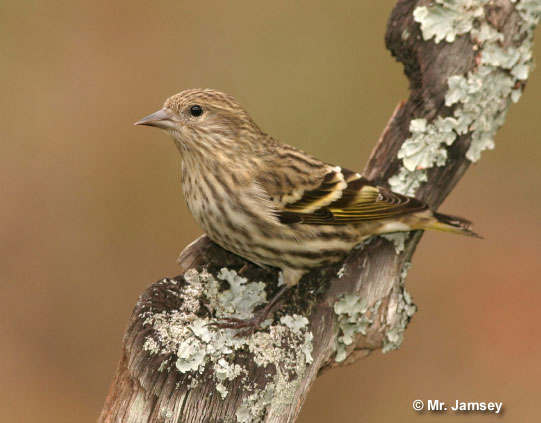Pine Siskins (Spinus pinus) are small, sparrow-sized birds known for their distinctive streaked brown plumage and distinct calls.
These finches are widespread throughout North America and can be found in open woodlands. Despite their small size, Pine Siskins are tough and hardy birds, able to survive cold winters and tough conditions by eating a wide variety of seeds.
On this page
Identification
Male and female Pine Siskins are identical in appearance. However, this bird has three subspecies that have slight differences in their plumage, although here we’re only going to introduce the one you can encounter in North America.
Pine Siskins are small songbirds that measure only 4.3-5.5 inches long, weigh around 0.4-0.6 ounces, and have a wingspan of 7.1-8.7 inches. They have sharp and short conical bills, short and rounded wings, and short and notched tails.
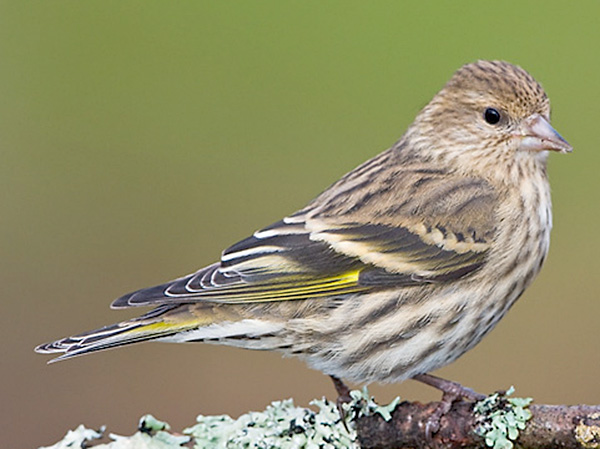
Photograph © Glenn Bartley.
Pine Siskin’s plumage helps them blend into their surroundings. Their brown upperparts and pale underparts are heavily streaked, and they have yellow patches on their wings and tails. There is also a green morph that has more yellow and green in its plumage, including its backs and undersides, and its underside is often less streaked.
Juvenile Pine Siskins are very similar to adults. However, the yellow in their plumage is duller and buffy. They have pink bills and look a bit ruffled.
Pine Siskins have beautiful complex warbling songs and rather distinct calls. A male’s song lasts for 3-13 seconds and consists of trills, ascending notes, and slurs. Their most distinct call is an ascending zreeeeet sound. During light, they make a shorter version of the call that sounds like zwee. The birds may also chirp, twitter, and let out very high-pitched soft chips.
Food
Pine Siskins primarily feed on seeds, such as seeds of spruce, pine, hemlock, cedars, larch, alder, birch, and many others. Their diet is mainly plant-based, although they might snatch up insects as well.
They feed on seeds, young shoots, flower parts, nectar, buds, and occasionally suet and mineral deposits, such as salt and ash.
They will eat the seeds of different conifers, such as spruce, larch, pine, cedars, and hemlock, of various deciduous trees, such as birch, maple, and sweetgum, and of various other plants, such as grasses, chickweed, thistle, sunflowers, and dandelions.
If seeds are unavailable, they will snack on young buds, soft stems and leaves of weeds, and visit bird feeders for different seeds and suet. During the summer, they will feast on insects, grubs, and spiders.
You can see them actively foraging in large flocks in trees, weeds, and shrubs, sometimes hanging upside down.
Nesting and Eggs
Pine Siskins nest in pairs or loose colonies. The male advertises himself by singing complex songs and flying above a female and offering her food.
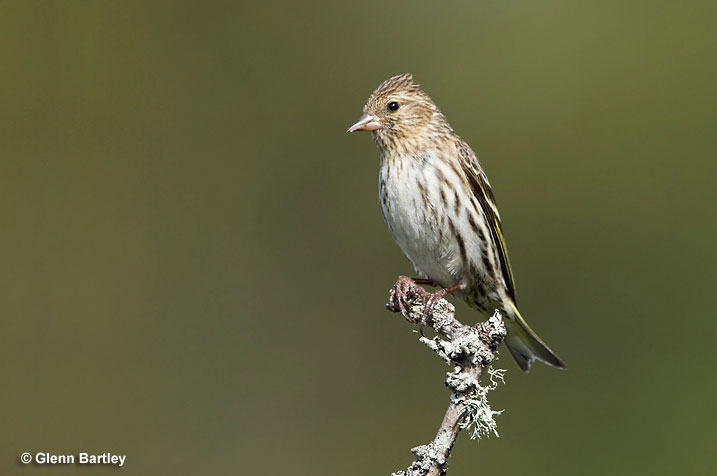
After the pair bonds for the season, the female builds a small nest at the end of a horizontal branch, most often in the middle of a tree (preferably a conifer) in a concealed spot.
The small cup of a nest is made of twigs, leaves, stems, grasses, and bark strips, and lined with soft materials, such as moss, feathers, fur, or thistle down. The male may help gather the materials.
The female Pine Siskin then lays 3-5 pale greenish blue eggs that are dotted with brown or reddish-brown. The female incubates the eggs for about 13 days while the male brings her food.
Nestlings leave the nest about 13-17 days after hatching, during which time both parents feed and take care of them. Independence is reached around three weeks after hatching.
Current Situation
Pine Siskins range throughout most of North and Central America. Their breeding range covers their northernmost range in Canada from Alaska to Newfoundland and Labrador. The birds migrate southward to the United States and Central America for the winter.
Migration patterns are erratic, as they tend to follow available food resources. Year-round populations can be found in the western United States, western Mexico, central Guatemala, and southern Canada.
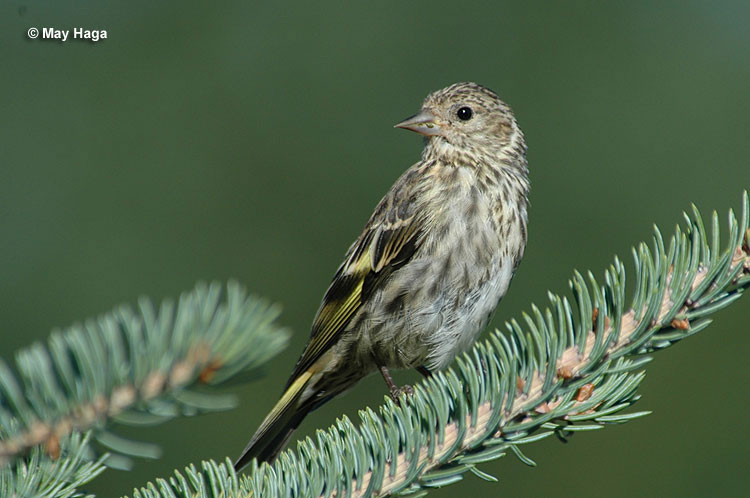
You can find these birds in coniferous or mixed forests and weedy areas. They prefer open woodlands, inhabiting also suburban woodlands, parks, and cemeteries. During the breeding season, they prefer to inhabit coniferous and mixed forests with clearings. During other times, you can see them in various other semi-open habitats, including fields, thickets, meadows, and even backyards.
Pine Siskins are listed as of least concern on the IUCN Red List. The main threat to its population lies in human interference.
Facts
- Contrary to how some bird species survive cold temperatures by lowering their heart rate and bodily functions, entering a kind of hibernation mode, Pine Siskins ramp up their metabolic rates to produce more heat. They also protect their eggs from cold by thoroughly insulating the nest.
- Pine Siskins sometimes intentionally forage close to birds that can crack larger seeds. They will then snatch seed fragments other birds leave behind.
- The oldest known Pine Siskin lived to be 9 years and 2 months old. Their average lifespan is lower due to predation and food availability.
- Pine Siskins can temporarily store seeds in their stomachs so that they can survive cold nights.
Pine Siskins migrate depending on the availability of food, meaning that their migration has no particular pattern.
Similar Species
Pine Siskins have four similar bird species. We have brought up the main differences between them and the Pine Siskin so it would be easier to identify them.
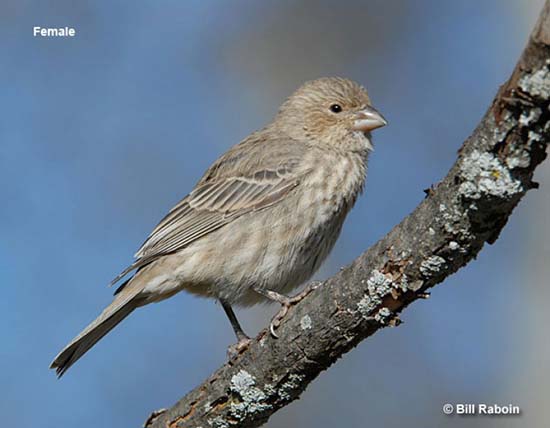
House Finch
Female and immature House Finches are quite similar to Pine Siskins with their overall brown and heavily streaked plumage.
However, House Finches lack the yellow patches on their wings and tail, and they also have thicker bills and longer tails and appear bigger overall.
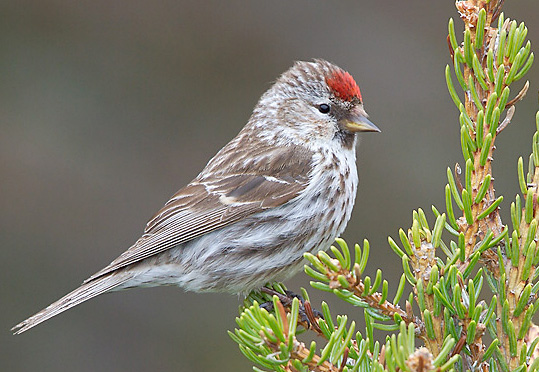
Common Redpoll. Photograph © Glenn Bartley.
Female and immature Common Redpolls have similar coloring and streaking as Pine Siskins do.
However, they lack yellow on their wings and tail, they have a small red patch on their head, and their beak is yellow.
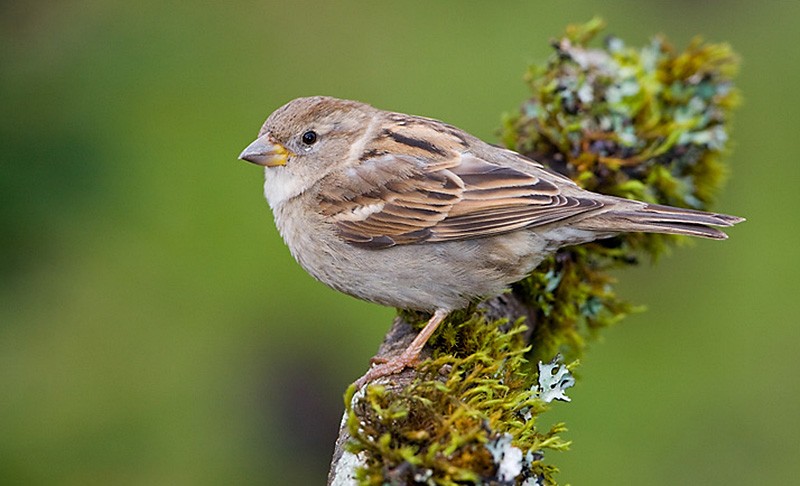
House Sparrow
If you’re just starting with birdwatching, you might confuse a Pine Siskin and a female House Sparrow.
Female House Sparrows lack the heavy streaking and yellow in their plumage.
Frequently Asked Questions
What is the difference between a Pine Siskin and a sparrow?
Pine Siskins and sparrows belong to different families and have differences in their plumage. Pine Siskins belong to the Fringillidae family and have heavy streaking whereas sparrows belong to the Passeridae family and lack the heavy streaking and the yellow in their plumage.
How do you identify Pine Siskins?
Pine Siskins appear brown overall, have heavy streaking across their body, and have yellow on their wings and tails. You can also listen for its distinct ascending zreeeeeet call.
Are Pine Siskins rare?
Pine Siskins are rather common birds within their range in North and Central America.
Why is it called siskin?
The name Siskin originates from German and refers to the chirp the birds make.
What is a pine siskin’s favorite food?
Pine Siskins prefer to eat small seeds, especially seeds of various conifers, such as spruce, pine, and birch, but they will also eat soft plant parts and insects.

